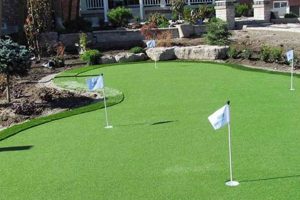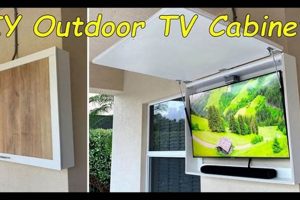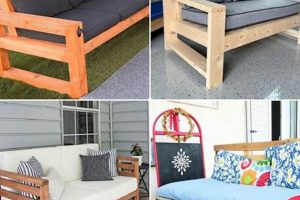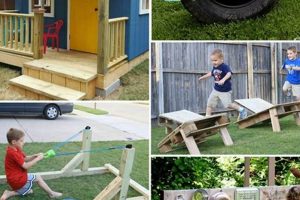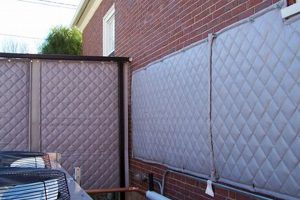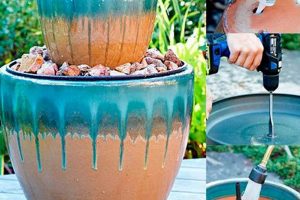The creation of site furnishings for exterior use through individual effort constitutes a significant segment of home improvement and woodworking. This endeavor typically involves utilizing readily available materials and tools to construct seating designed to withstand the elements. As an example, an individual might repurpose reclaimed lumber and basic hardware to assemble a sturdy and aesthetically pleasing seat for placement in a garden or on a patio.
Such projects offer numerous advantages, including cost savings relative to commercially manufactured products and the opportunity to customize designs to specific spatial requirements and aesthetic preferences. Historically, self-sufficient construction of outdoor furniture has been a prevalent practice, reflecting a tradition of resourcefulness and a desire for personalized outdoor living spaces. The practice empowers individuals to exercise creative control over their immediate environment.
The subsequent discussion will address fundamental considerations for successful execution, encompassing material selection, structural design, construction techniques, and finishing methods. These topics aim to provide a comprehensive framework for individuals undertaking such ventures, ensuring durability, functionality, and visual appeal in the finished product.
Essential Considerations for Outdoor Seating Construction
Successful implementation of a self-directed exterior seating project necessitates careful attention to several key factors. The following points outline crucial considerations for ensuring structural integrity, longevity, and aesthetic suitability.
Tip 1: Material Selection: Choose weather-resistant materials such as treated lumber, cedar, redwood, or recycled plastic. Untreated materials will require regular maintenance and may exhibit premature degradation.
Tip 2: Structural Design: Employ robust joinery techniques like mortise and tenon, dado joints, or through bolts for secure connections. A well-engineered frame is critical for stability and load-bearing capacity.
Tip 3: Foundation and Support: Ensure adequate ground clearance to prevent moisture damage. Consider concrete footings or level gravel beds for stable support, particularly on uneven terrain.
Tip 4: Fastener Selection: Utilize corrosion-resistant fasteners, such as stainless steel or galvanized screws and bolts. Standard hardware may rust and weaken over time, compromising structural integrity.
Tip 5: Surface Preparation: Thoroughly sand all surfaces to eliminate splinters and create a smooth finish. This step is crucial for both aesthetics and safety.
Tip 6: Protective Coatings: Apply a high-quality exterior-grade sealant, stain, or paint to protect the wood from moisture, UV radiation, and insect infestation. Regular reapplication may be required.
Tip 7: Drainage Considerations: Design the seating surface with slight gaps or slopes to facilitate water runoff. Standing water can accelerate wood decay and create unsanitary conditions.
Careful attention to these considerations will yield a durable and aesthetically pleasing outdoor seating solution, offering years of reliable service. Prioritizing quality materials and sound construction practices is paramount.
The subsequent sections will delve into specific project ideas and detailed construction plans, building upon the fundamental principles outlined above. This information provides a solid foundation for successful project completion.
1. Material Weather Resistance
Material weather resistance is a critical determinant of the lifespan and aesthetic quality of seating produced through individual construction efforts. The selection of materials directly impacts the structure’s ability to withstand environmental factors such as moisture, ultraviolet radiation, temperature fluctuations, and biological degradation. Inadequate resistance to these elements results in premature deterioration, necessitating frequent repairs or complete replacement. For instance, untreated softwood, when exposed to outdoor conditions, is susceptible to rot, insect infestation, and warping, leading to structural failure within a relatively short timeframe. In contrast, the utilization of naturally durable hardwoods like teak or cedar, or pressure-treated lumber, significantly extends the lifespan of the structure. This is due to their inherent resistance to decay and insect damage. Therefore, prioritizing material weather resistance is paramount when considering the project’s long-term viability and cost-effectiveness.
The practical application of this understanding extends beyond mere material selection. It informs the design and construction techniques employed. For example, incorporating drainage features into the seating surface, such as gaps between slats, minimizes water accumulation and reduces the risk of rot. Furthermore, the application of protective coatings, such as sealants or paints specifically formulated for exterior use, provides an additional barrier against environmental damage. The choice of fasteners, such as stainless steel screws, also plays a crucial role in preventing corrosion, which can compromise structural integrity over time. A comprehensive approach to weather resistance, encompassing material selection, design considerations, and protective treatments, is essential for ensuring the longevity of the finished product.
In conclusion, material weather resistance represents a foundational element for any individually-constructed outdoor seating project. Its influence extends from the initial material selection to the final application of protective coatings. Overlooking this aspect leads to inevitable deterioration and diminished structural integrity, while a proactive approach results in a durable, aesthetically pleasing, and cost-effective addition to the outdoor environment. Challenges remain in balancing the cost of weather-resistant materials with budgetary constraints, requiring careful consideration and informed decision-making throughout the planning and construction phases. The consideration of tool accessibility in this balancing act is also important.
2. Structural Integrity
Structural integrity is paramount in the realm of self-directed exterior seating construction. The inherent safety and longevity of the finished product are directly contingent upon its capacity to withstand imposed loads and environmental stresses without exhibiting failure. A bench constructed without adequate structural design principles poses significant risks to users and necessitates premature replacement, negating the cost savings associated with individual construction. The selection of appropriate joinery techniques, coupled with the use of materials possessing sufficient load-bearing capacity, is fundamental to achieving a stable and durable structure. For instance, a bench frame utilizing simple butt joints secured with nails is inherently weaker than one employing mortise and tenon joints reinforced with adhesive and mechanical fasteners. The former is prone to failure under moderate weight or prolonged exposure to weather, while the latter offers significantly enhanced resistance to both.
The practical application of structural engineering principles in seating construction extends to considerations of weight distribution, material properties, and fastener selection. Uneven weight distribution, resulting from inadequate support or poorly placed legs, can induce stress concentrations that lead to cracking or joint separation. Choosing lumber with sufficient thickness and density is crucial for withstanding these stresses. Furthermore, the selection of fasteners exhibiting adequate shear and tensile strength is essential for maintaining joint integrity. Corrosion-resistant fasteners, such as stainless steel, are particularly important in exterior applications where exposure to moisture can accelerate degradation. A comprehensive understanding of these factors informs the design process and ensures that the finished structure is capable of safely supporting intended loads.
In conclusion, structural integrity represents a non-negotiable aspect of seating projects undertaken through individual effort. Its absence results in unsafe and short-lived structures, undermining the purpose of the project. A thorough understanding of load-bearing principles, material properties, and appropriate joinery techniques is essential for achieving a durable and safe outcome. While challenges may arise in balancing structural requirements with aesthetic preferences and budgetary constraints, prioritizing structural integrity ensures the long-term usability and safety of the seating structure.
3. Ergonomic Design
The integration of ergonomic design principles into self-constructed outdoor seating is crucial for ensuring user comfort and minimizing potential physical strain. Such design considerations extend beyond mere aesthetics, impacting posture, support, and overall user experience. Neglecting these principles can result in discomfort, fatigue, and even long-term health issues.
- Seat Height and Depth
Appropriate seat height is essential for facilitating easy ingress and egress. A height that is too low can strain the knees and back, while one that is too high can cause dangling feet and impede circulation. Similarly, adequate seat depth ensures proper thigh support, preventing pressure points and promoting comfortable sitting posture. Real-world examples include benches with heights optimized for the average adult or those customized to accommodate specific user populations, such as children or the elderly. Seat height and depth is therefore directly related to outdoor bench diy.
- Backrest Angle and Lumbar Support
The angle of the backrest should provide adequate support for the spine, encouraging an upright posture and reducing strain on the lower back. The incorporation of lumbar support, either through a curved backrest or a separate cushion, further enhances comfort and reduces the risk of back pain. Public park benches often demonstrate varying degrees of backrest angle and lumbar support, impacting their suitability for prolonged use. The angle and support are important aspects to address during outdoor bench diy.
- Armrest Height and Placement
Armrests, when properly positioned, provide support for the arms and shoulders, reducing muscle fatigue and promoting relaxation. The height of the armrests should allow for a natural arm position, avoiding shoulder elevation or slouching. Armrest design is often overlooked, leading to discomfort during extended seating. Improper height can cause strain in the neck and shoulders. So, armrest height is important if you want a good ergonomic design for outdoor bench diy.
- Material Considerations
The choice of materials impacts user comfort and can influence the ergonomic properties of seating. Smooth, contoured surfaces are preferable to rough or abrasive materials that can cause discomfort or skin irritation. Furthermore, the material’s thermal properties affect user experience in varying weather conditions. For example, metal benches can become uncomfortably hot in direct sunlight, while wood benches tend to remain cooler. Material properties are important for a well-rounded ergonomic design for outdoor bench diy.
These facets collectively contribute to the overall ergonomic quality of seating. Self-constructed outdoor benches should incorporate these principles to ensure user comfort, promote healthy posture, and minimize the risk of physical strain. Balancing aesthetic preferences with ergonomic considerations requires careful planning and attention to detail, ultimately resulting in a functional and enjoyable addition to the outdoor environment. Careful planning to the dimensions are also needed for outdoor bench diy.
4. Finishing Protection
Finishing protection represents a critical phase in the construction of outdoor seating, directly impacting its longevity and resistance to environmental degradation. This stage involves applying protective coatings to the completed structure, effectively creating a barrier against moisture, ultraviolet radiation, insect infestation, and physical abrasion. The absence of adequate finishing protection invariably leads to premature deterioration of the underlying material, resulting in structural weakening, aesthetic degradation, and ultimately, the need for costly repairs or replacement. As a component of self-directed exterior seating projects, finishing protection cannot be viewed as an optional step but rather as an integral element that safeguards the investment of time, effort, and resources. Consider a basic bench constructed from untreated pine; without proper finishing, it may succumb to rot and insect damage within a single season, while the same bench, treated with a quality sealant, stain, or paint, could endure for many years. The cause-and-effect relationship is undeniable; proper protection ensures structural integrity and extends the service life of the seating.
The practical significance of finishing protection extends beyond mere preservation. It allows for customization of the seating’s appearance, enabling builders to match existing outdoor dcor or create unique aesthetic statements. Stains can enhance the natural grain of wood, while paints offer a wide range of color options. Moreover, certain finishes provide enhanced UV protection, preventing fading and discoloration of the material over time. For example, using a marine-grade varnish on a teak bench not only protects it from moisture but also preserves its rich color and prevents cracking caused by prolonged exposure to sunlight. The choice of finish should be carefully considered, taking into account the type of material used, the intended aesthetic outcome, and the level of protection required for the specific outdoor environment. Different finishes also impact ergonomic properties of the bench, as discussed previously. Proper application of these finishes will influence the longevity of the product created during the outdoor bench diy. Proper planning to the dimensions are also needed for outdoor bench diy.
In conclusion, finishing protection is an indispensable aspect of constructing durable and aesthetically pleasing outdoor seating through individual effort. By mitigating the damaging effects of environmental factors, it ensures the longevity and functionality of the structure. While the selection and application of appropriate finishes may require additional time and expense, the benefits far outweigh the costs in terms of reduced maintenance, extended service life, and enhanced aesthetic appeal. Challenges may arise in selecting the optimal finish for specific materials and environmental conditions, but thorough research and careful application will yield a long-lasting and visually appealing seating solution. Also, all prior factors, if addressed properly, will have no significance if the finishings do not protect the product created during the outdoor bench diy project.
5. Site Integration
The effective incorporation of individually constructed outdoor seating into its surrounding environment, termed site integration, profoundly influences its usability, aesthetic appeal, and perceived value. Careful consideration of spatial context is crucial for creating a harmonious and functional outdoor space, ensuring that the seating complements rather than detracts from its surroundings.
- Spatial Harmony and Scale
The dimensions and proportions of seating should align with the scale of the surrounding landscape or architectural features. An oversized bench in a small garden can feel overwhelming, while an undersized bench in a sprawling park may appear insignificant. Consideration of existing sightlines and pedestrian traffic patterns is also essential. A bench strategically placed to capitalize on a scenic view enhances the user experience. Scale and proportions are important when planning outdoor bench diy.
- Material and Style Consistency
The materials and stylistic elements of the seating should complement the existing landscape or architectural materials. A rustic wooden bench may be well-suited for a natural garden setting, while a sleek metal bench may be more appropriate for a modern urban environment. Incongruous materials or styles can create visual discord and detract from the overall aesthetic. Material selection influences outdoor bench diy.
- Functional Compatibility
The intended use of the seating should inform its placement and design. A bench intended for relaxation may be positioned in a quiet, shaded area, while a bench intended for social interaction may be placed in a more open and accessible location. Proximity to pathways, gardens, or other outdoor features should also be considered to maximize functionality. Intended use dictates your plans in outdoor bench diy.
- Environmental Impact Mitigation
Placement of seating should minimize its impact on the surrounding environment. Avoid placing benches directly on fragile vegetation or in areas prone to erosion. Consider the potential for shading or disrupting natural drainage patterns. Sustainable material choices and construction practices further contribute to minimizing environmental impact. Environmental impact mitigation is part of outdoor bench diy.
The preceding facets demonstrate that site integration is not merely an aesthetic consideration but a comprehensive approach to ensuring the functionality, harmony, and sustainability of outdoor seating. Successful projects involving self-directed exterior seating construction integrate the structure seamlessly into its environment, enhancing the user experience and minimizing negative impacts on the surrounding landscape. By considering the spatial context, material compatibility, intended use, and environmental impact, individuals can create outdoor seating that is both functional and visually appealing, improving the value of the property by increasing aesthetics. This includes the planning stages of outdoor bench diy.
6. Cost Efficiency
Cost efficiency represents a significant driver in the decision to undertake exterior seating projects through individual construction. The primary motivation often stems from the potential to realize considerable savings compared to purchasing commercially manufactured alternatives. This differential arises from bypassing retail markups, leveraging readily available or reclaimed materials, and utilizing existing tools. The effect is a lower capital outlay for a functional, and often aesthetically pleasing, outdoor amenity. For example, constructing a basic garden bench from reclaimed lumber and standard hardware may cost significantly less than purchasing a comparable pre-built model from a furniture retailer. This factor makes self-directed construction an attractive option for individuals with budget constraints or a desire to minimize expenses.
However, a narrow focus solely on minimizing initial cost can lead to unintended consequences and compromise long-term value. Sacrificing material quality or neglecting proper construction techniques in the pursuit of immediate savings may result in a structure that is prone to premature failure, requiring frequent repairs or complete replacement. Consequently, a more holistic approach to cost efficiency is essential. This entails carefully balancing material selection, design complexity, and labor investment to achieve a durable and aesthetically acceptable outcome at a reasonable price. The trade-off is deciding how much to spend on the different features. In essence, prioritizing long-term value over short-term savings is the key to realizing true cost efficiency in self-directed exterior seating projects. Tool accessibility will also be a factor. Having access to more tools is generally related to a less expensive project.
In conclusion, cost efficiency plays a pivotal role in the decision to pursue self-directed outdoor seating construction, offering the potential for significant savings compared to commercial alternatives. However, a balanced perspective is crucial, considering not only initial costs but also the long-term durability and maintenance requirements of the finished product. By prioritizing informed material selection, sound construction practices, and a holistic approach to value, individuals can maximize cost efficiency and create outdoor seating that is both functional and economical. Challenges remain in accurately estimating project costs and balancing budgetary constraints with desired quality and aesthetic outcomes. This must be considered during outdoor bench diy projects.
7. Tool Accessibility
Tool accessibility exerts a direct influence on the feasibility and complexity of outdoor seating endeavors undertaken through individual effort. The availability of specific tools and equipment dictates the range of possible designs, construction techniques, and material choices. A well-equipped workshop enables the execution of intricate joinery, the precise shaping of materials, and the efficient application of finishes. Conversely, limited access to tools restricts design options, potentially necessitating simpler construction methods and impacting the overall quality and durability of the finished structure. For instance, the creation of mortise and tenon joints typically requires specialized tools such as a mortising machine or chisels, while simpler butt joints can be achieved with basic saws and fasteners. The former offers superior structural strength, but its accessibility is contingent upon the availability of the necessary tools.
The practical ramifications of tool accessibility extend beyond technical capabilities. It directly impacts project costs, skill requirements, and time investment. Individuals lacking certain tools may opt to purchase them, increasing the initial expenditure. Alternatively, they may adapt their design or construction methods to accommodate their existing tools, potentially compromising the desired aesthetic or structural integrity. Furthermore, the absence of specialized tools may necessitate more time-consuming manual labor, increasing the overall project duration. A common example is the use of hand saws in lieu of power saws, which significantly increases the time required to cut lumber and can affect the precision of the cuts. Therefore, a careful assessment of tool accessibility is essential during the planning phase of any outdoor seating construction project.
In conclusion, tool accessibility constitutes a fundamental constraint that shapes the scope and execution of self-directed outdoor seating projects. Its influence permeates design choices, construction techniques, material selection, and project costs. Overlooking this factor can lead to unexpected challenges, compromised quality, or project abandonment. Prioritizing a realistic assessment of available tools, coupled with a willingness to adapt designs and construction methods accordingly, is crucial for achieving a successful and satisfying outcome. This includes considering the balancing act between prior factors discussed. Challenges may persist in acquiring necessary tools or adapting to limitations, but a strategic approach to tool accessibility enhances the likelihood of completing a durable, aesthetically pleasing, and cost-effective outdoor seating structure.
Frequently Asked Questions
The following section addresses common inquiries and misconceptions regarding the construction of outdoor seating through individual effort. The information provided aims to offer clarity and guidance for those considering such projects.
Question 1: What constitutes the most durable material choice for exterior seating construction?
Durable material options include naturally rot-resistant woods such as teak, cedar, and redwood. Pressure-treated lumber also offers significant resistance to decay and insect infestation. Recycled plastic lumber presents a low-maintenance and long-lasting alternative.
Question 2: What joinery techniques provide the greatest structural integrity for outdoor benches?
Mortise and tenon joints, secured with adhesive and mechanical fasteners, offer exceptional strength and resistance to racking. Dado joints and through bolts also provide robust connections. Simple butt joints are generally inadequate for supporting significant loads or withstanding prolonged exposure to weather.
Question 3: How can potential structural failure be mitigated in self-constructed outdoor seating?
Careful attention to weight distribution, material selection, and fastener specifications is crucial. Uneven weight distribution can induce stress concentrations that lead to cracking or joint separation. Lumber with sufficient thickness and density should be chosen to withstand these stresses. Corrosion-resistant fasteners are essential for preventing degradation.
Question 4: What protective finishes provide the most effective defense against environmental degradation?
Exterior-grade sealants, stains, and paints formulated for outdoor use offer a barrier against moisture, ultraviolet radiation, and insect infestation. Marine-grade varnishes provide enhanced protection against moisture and sunlight. Regular reapplication of protective coatings is typically required to maintain their effectiveness.
Question 5: What ergonomic considerations should inform the design of self-constructed outdoor seating?
Appropriate seat height and depth are essential for facilitating easy ingress and egress. The angle of the backrest should provide adequate support for the spine, encouraging an upright posture. Armrests, when properly positioned, provide support for the arms and shoulders, reducing muscle fatigue.
Question 6: How can the cost of an project be minimized without compromising its quality or durability?
Leveraging reclaimed materials, utilizing existing tools, and adopting simpler designs can significantly reduce project costs. Prioritizing long-term value over short-term savings is essential; sacrificing material quality or neglecting proper construction techniques can lead to premature failure and increased expenses in the long run.
In summary, careful planning, informed material selection, sound construction practices, and diligent application of protective finishes are essential for achieving a successful and enduring seating structure.
The following section will describe how to keep your project long-lasting.
Concluding Remarks on Outdoor Bench DIY
The preceding analysis has detailed the multifaceted considerations inherent in self-directed exterior seating projects. From material selection and structural integrity to ergonomic design, finishing protection, site integration, cost efficiency, and tool accessibility, a comprehensive understanding of these factors is paramount. Neglecting any of these aspects risks compromising the durability, functionality, and aesthetic appeal of the finished product.
Therefore, individuals embarking on endeavors to create seating should approach the process with diligence and a commitment to best practices. This ensures that their efforts yield lasting value and contribute positively to the surrounding environment. Success in these projects requires combining technical skill, design acumen, and a dedication to long-term sustainability.


